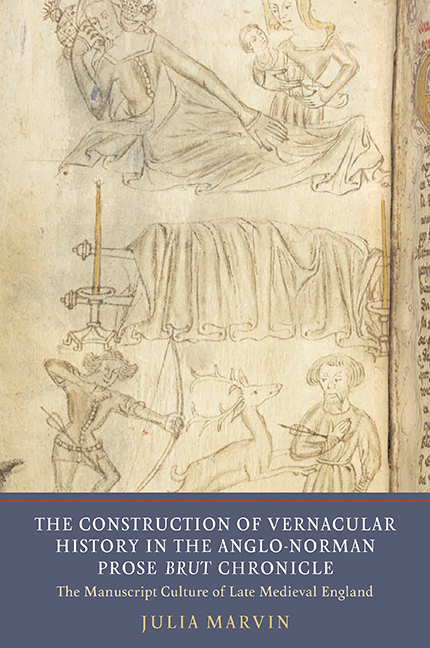 The Construction of Vernacular History in the Anglo-Norman Prose Brut Chronicle
The Construction of Vernacular History in the Anglo-Norman Prose Brut Chronicle Book contents
- Frontmatter
- Dedication
- Content
- List of Plates
- Acknowledgments
- Abbreviations
- A Note on Proper Names, Transcriptions, and Translations
- Introduction: Recognizing the Prose Brut Tradition
- Part I Construction
- Part II Reconstruction and Response
- 6 Evidence of Production
- 7 The Company That Prose Bruts Keep
- 8 Ordinatio, Apparatus, and Annotation
- 9 History Illustrated
- Conclusion: Merlin's Power
- Bibliography
- General Index
- Index of Manuscripts Cited
6 - Evidence of Production
from Part II - Reconstruction and Response
Published online by Cambridge University Press: 01 February 2018
- Frontmatter
- Dedication
- Content
- List of Plates
- Acknowledgments
- Abbreviations
- A Note on Proper Names, Transcriptions, and Translations
- Introduction: Recognizing the Prose Brut Tradition
- Part I Construction
- Part II Reconstruction and Response
- 6 Evidence of Production
- 7 The Company That Prose Bruts Keep
- 8 Ordinatio, Apparatus, and Annotation
- 9 History Illustrated
- Conclusion: Merlin's Power
- Bibliography
- General Index
- Index of Manuscripts Cited
Summary
Produced in Britain from the early fourteenth to the late fifteenth centuries, and on the Continent during the later fifteenth century, the surviving corpus of more than fifty Anglo-Norman prose Brut manuscripts clearly served a variety of audiences, both before and after its Long Version was translated into English. Extant manuscripts range widely in script, context, and size: the smallest, Add. 35092, a nicely produced later fourteenth century copy of the Oldest Version, could fit in a pocket, while the largest, Paris, Bibliothèque Sainte-Geneviève (hereafter BSG) 935, a lavish fifteenth-century Continental text with a program of illustrations, would require a support of some sort to be read. Some manuscripts are the work of many hands; some seem likely to have been written entirely by one person, in some haste, perhaps for personal use. It would do violence to the tradition to try to identify one kind of Anglo- Norman prose Brut, or one course of production, as normative.
The manuscripts themselves provide little information as to their origin and early provenance – another factor that may have contributed to neglect of the corpus, since manuscripts with identifiable origins often attract more scholarly attention. When present at all, the earliest inscriptions of ownership tend to begin with very late fifteenth century and sixteenth century owners. Especially in the earlier manuscripts, less formal, more documentary scripts are common: the Anglo-Norman prose Brut bears witness to the rise of highly current scripts, as well as other economizing measures, in fourteenth-century bookwriting. How, by whom, where, and in how organized a way the Anglo- Norman texts were produced remains an open question.
Mooney and Matheson have found evidence for the existence of a fifteenthcentury secular work-group responsible for the production of multiple copies of the Middle English prose Brut from a single exemplar, possibly mass-producing an extremely popular text on spec rather than awaiting a commission. Although their findings so far apply to only a handful of the extant manuscripts of the English Brut, they are a reminder of just how much stands to be learned through deeper study of the corpus.
- Type
- Chapter
- Information
- The Construction of Vernacular History in the Anglo-Norman Prose Brut ChronicleThe Manuscript Culture of Late Medieval England, pp. 131 - 162Publisher: Boydell & BrewerPrint publication year: 2017
